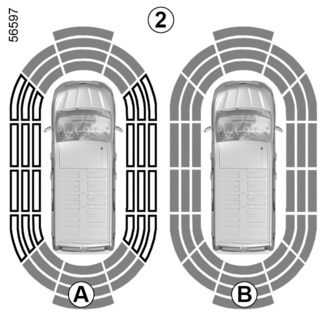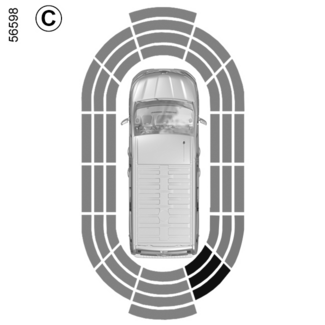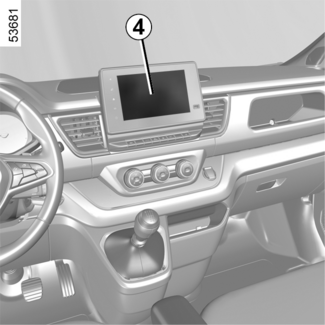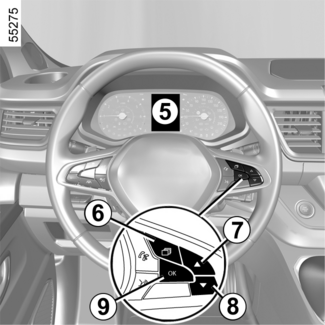Back to the list







Parking distance control
Parking distance control

Ultrasonic sensors, indicated by arrows 1, are fitted in the bumpers to detect obstacles near the vehicle.
This measurement is indicated by beeps which become more frequent the closer you come
to the obstacle, until they become a continuous beep when the vehicle is approximately
20 to 30 centimetres from the obstacle.
Depending on the equipment, the system detects obstacles in front and, behind and
to the sides of the vehicle.
The Park Assist system is only activated when the vehicle is driven at a speed below
approximately 6 mph (10 km/h).
The function does not take into account towing or carrying systems that are not recognised
by the system.
WARNING
This function is an additional driving aid. Under no circumstances should it replace
the driver's care or responsibility whilst reversing.
The driver should always be ready for sudden incidents while driving: always ensure
that there are no small, narrow moving obstacles (such as a child, animal, pushchair,
bicycle, stone, post, etc.) in the blind spot when manoeuvring.
Location of the ultrasonic sensors 1
Ensure that the area around the ultrasonic sensors indicated by the arrows 1 is not obscured (by dirt, mud, snow, a badly fitted/attached number plate), impacted,
modified (including paintwork) or obstructed by any accessory fitted to the rear and/or,
depending on the vehicle, to the front or sides of your vehicle.
Operation

The screen 2 shows the vehicle surroundings, accompanied by beeps.
Depending on the equipment, it may be necessary to travel a few metres before the
side detection is activated.
If all areas have a grey background, the whole area around the vehicle is being monitored:
- display A: analysis of vehicle surroundings in progress;
- display B: analysis of vehicle surroundings complete.
Obstacle detection

The system is able to detect most objects located near the rear and, depending on
the equipment, near the front and sides of the vehicle.
The audible signal frequency will increase as the vehicle approaches on obstacle,
until it becomes a solid beep at approximately 20 cm for an obstacle detected on the
sides and approximately 30 cm for an obstacle detected to the front or rear.
The area where the obstacle has been detected is displayed (display C). Depending on the vehicle, the area is displayed in green, orange (or yellow depending
on the vehicle) or red, depending on the proximity of the detected object.
Note:
Tip
In the event of a change in trajectory during a manoeuvre, the risk of collision with
an obstacle may be signalled late.
Special case of obstacles detected on the side

Depending on the direction of the wheels, the system determines the trajectory of
the vehicle and notifies the driver if there is a risk or not of a collision with
an obstacle 3 to the side of the vehicle.
If a side obstacle is detected:
- the beeps become faster and then sound continuously as the obstacle gets nearer. Green, orange and red zones will be shown on the display D;
- if there is no risk of collision, no beep will sound when approaching the obstacle. Depending on the vehicle, the area where the obstacle 3 has been detected is shown interspersed.
Tip
In the event of a change in trajectory during a manoeuvre, the risk of collision with
an obstacle may be signalled late.
Activation/deactivation
Activation/deactivation from the multimedia screen

From the "Vehicle" world on your multimedia screen 4, press the "Parking aids" menu. Activate or deactivate areas covered by the ultrasonic
detectors.
Note: depending on the vehicle, the "rear" detection zone cannot be deactivated.
Activating/deactivating the system from the trip computer

- With the vehicle stationary, press the 6 switch as many times as required to reach the "VEHICLE" tab;
- press control 7 or 8 repeatedly to reach the "DRIVING ASSIST" menu. Press switch 9OK;
- press control 7 or 8 repeatedly until you reach the "Parking" menu. Press switch 9OK;
- press switch 8OK to activate or deactivate the function;
function activated
function deactivated
Parking distance control automatic deactivation
The system is deactivated:
- when the vehicle speed is above approximately 6 mph (10 km/h);
- depending on the vehicle, when the vehicle is stationary for more than approximately five seconds and an obstacle is detected (such as when in a traffic jam, etc.);
- when you are in N or P position;
- when an operating fault is detected.
Note: depending on the vehicle, if the vehicle is fitted with a towbar recognised by the
system, only the rear Park Assist function is deactivated.
Adjustment
WARNING
For safety reasons, carry out any adjustments while the vehicle is stationary.
Tip
Each time the vehicle is started, the function continues the mode saved the last time
the engine was stopped.
Adjusting settings from the multimedia screen 4

Vehicle stationary, from the "Vehicle" world on your multimedia screen 4, press the "Parking aids" menu.
Please refer to the multimedia instructions for further information.
Adjusting settings from the trip computer 5

- With the vehicle stationary, press the 6 switch as many times as required to reach the "VEHICLE" tab;
- press control 7 or 8 repeatedly to reach the "DRIVING ASSIST" menu. Press switch 9OK;
- press control 7 or 8 repeatedly until you reach the "Parking" menu. Press switch 9OK.
Deactivating the system sound
(depending on the vehicle)
Activate or deactivate the parking distance control sound.
Note: if you deactivate the sound, you will no longer be notified with beeps when approaching
an obstacle.
Parking distance control audio volume
Adjust the Park Assist volume using the volume bar.
Tip
Each time the vehicle is started, the function continues the mode saved the last time
the engine was stopped.
Special cases
You can manually deactivate sound alerts or, depending on the vehicle, the detection
zone concerned:
- if towing, carrying or trailer equipment that is unrecognised by the system is present in front of the ultrasonic sensors;
- in the event of damage to the ultrasonic sensors.
Note: if the sound is deactivated, the displays will continue to warn you erratically.
Operating faults
When the system detects a malfunction: either a sound signal warns you for about three
seconds when the reverse gear is engaged, accompanied by the "Check Parking sensors" message on the instrument panel, or the system does not produce a sound or display
when the reverse gear is engaged.
Check that the ultrasonic sensors are clean. If it the fault persists, consult an
approved dealer.
Tip
System servicing/repairs
- In the event of an impact, the alignment of the ultrasonic sensors may be altered and its operation may consequently be affected. Deactivate the function and consult an authorised dealer.
- Any work in the area where the ultrasonic sensors are located (repairs, replacements etc.) must be carried out by a qualified professional.
Only an authorised dealer is qualified to service the system.
System disturbance
Some conditions can disrupt or damage the system operation, for example:
- poor weather conditions (rain, snow, hail, black ice, etc.);
- some types of noise (motorcycle, lorry, pneumatic drill, etc.);
- fitting an non-compatible towing ball or hook.
Risk of false alarms or absence of warnings
If the system behaves abnormally contact an authorised dealer.
Limitation of the system operation
- The area around the sensors must be kept clean and free of any modifications in order to ensure the proper operation of the system.
- Small objects moving close to the vehicle (motorcycles, bicycles, pedestrians, etc.) may not be recognised by the system.
- The system may not detect objects that are too close to the vehicle.
- The system may not provide a warning when the other vehicles or objects are travelling at a significantly different speed.
- When there is a change in trajectory during a manoeuvre, the system may be slow in reporting obstacles.